I started making no-knead bread in 2010 and it has continued to be my favorite way to make homemade bread because it’s incredibly simple, it doesn’t require a lot of effort, and it makes the most deliciously crusty bakery-style bread ever. To make this no-knead bread recipe you only need four ingredients (including water) and a little bit of time. No fancy equipment or techniques needed!
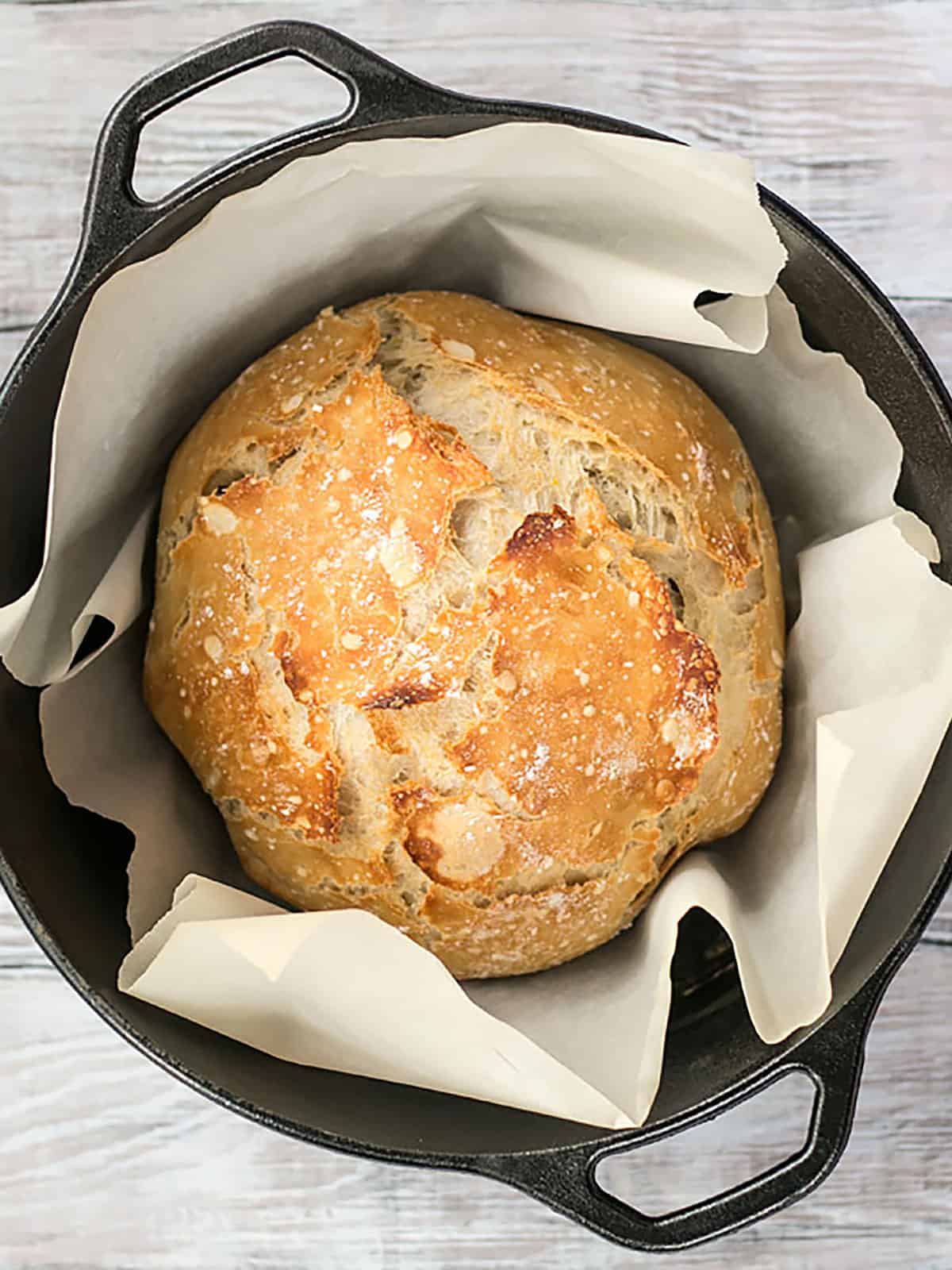
This post contains some affiliate links, which means that we make a small commission off items you purchase at no additional cost to you.
“I’ve made this twice and it was amazing! Hard to believe something so simple can come together to be something so amazing!”
-Melissa
What Is No Knead Bread?
No-knead bread is an ancient technique for making delicious loaves of bread by utilizing a long fermentation time to develop the gluten the flour instead of hand kneading. Gluten is the protein that gives bread its strength, allowing it to rise into a fluffy loaf, and have that deliciously chewy texture. Kneading bread dough develops gluten quickly, but is quite labor-intensive. If given enough time, yeast can develop the gluten in the dough without the need for manual needing.
Ingredients for No Knead Bread
The best part about this no-knead bread recipe is that it only requires four ingredients, including water, and you still get an incredibly flavorful bread. Here’s all you’ll need to make your own homemade no-knead bread:
- Flour: Our version of no-knead bread was developed using all-purpose flour because that is what we most commonly have on hand. That being said, using bread flour will create even better results. Just keep in mind that bread flour tends to absorb more water than all-purpose flour, so you may need to adjust the ratios slightly.
- Yeast: For this type of bread, we use instant yeast or bread machine yeast, both of which do not need to be activated first by proofing in warm water. You can simply add them to your dry ingredients and go!
- Salt: Without the proper amount of salt, homemade bread will have no flavor, so it’s imperative that you do not skip the salt.
- Water: Water hydrates the flour to create the dough. Because this technique uses a longer ferment time, you can use room-temperature water and you do not have to “wake up” the yeast with warm water. The yeast will have plenty of time to activate as it rests.
What Kind of Yeast to Use
It’s very important to use the correct type of yeast for this recipe. Instant yeast and bread machine yeast are special because they do not require mixing with warm water to “wake up” before adding to a recipe. You can simply stir them into the dry ingredients and they will activate instantly upon hydration, so that is what we use for this super simple no-knead bread technique. Active Dry yeast, on the other hand, needs to be specifically activated in warm water first. If you use active dry yeast in this recipe using the technique below, the bread will likely not rise.
Do I Need to Use a Dutch Oven?
Using a preheated Dutch oven does create the best results because it gives the bread an extra intense boost of heat while retaining all of the moisture and steam. That being said, I have made no-knead bread on a sheet pan with great results! I suggest adding a pan with an inch or so of water on the bottom rack of your oven to create steam if you’re baking your bread on a sheet pan.
If possible, I would suggest investing in a Dutch Oven because they are easily one of the most flexible and useful pieces of cookware. We love our Amazon Basics 6-Quart Enameled Dutch Oven as a very affordable alternative to Le Creuset. Lodge also makes very affordable Enameled Dutch Ovens and plain Cast Iron Dutch Ovens (like the one used in the photos here).
Short Fermentation vs. Long Fermentation
You can make no-knead bread using either a long fermentation (12-18 hours) or a short fermentation (about 2 hours). The difference is that you’ll need more yeast to do the short fermentation and the flavor does not develop quite as deeply. That being said, short fermentation no-knead bread is a great option when you haven’t planned ahead!
Long Fermenation: Follow the instructions below, using ¼ tsp yeast and fermenting the dough for 12-18 hours.
Short Fermentation: Use 2 tsp yeast (or one ¼ oz. packet) and ferment the dough for about 2 hours at room temperature.
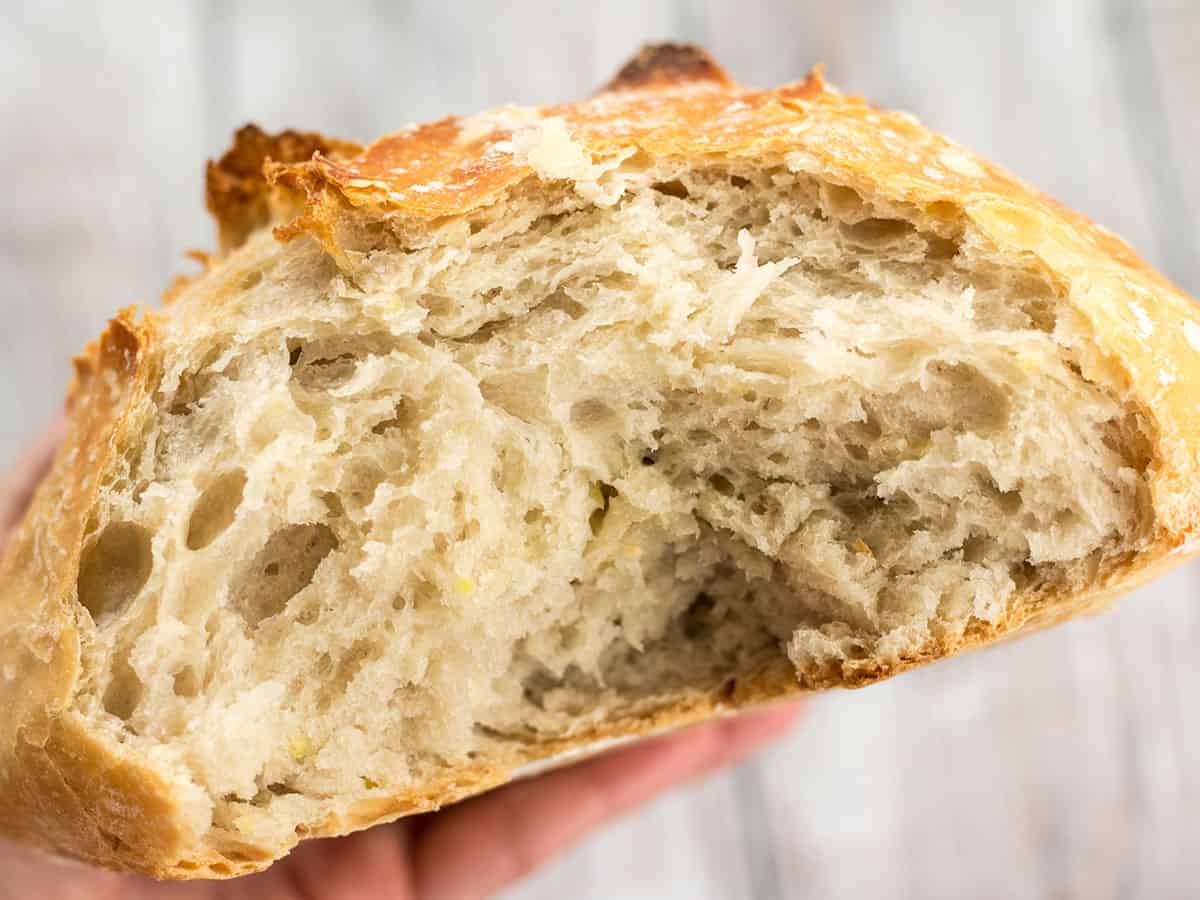
No-Knead Bread
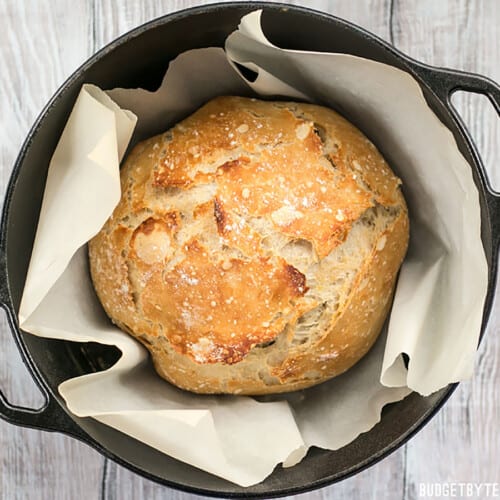
Ingredients
- 3 cups all-purpose flour ($0.29)
- 1/4 tsp instant yeast or bread machine yeast* ($0.02)
- 1.5 tsp salt ($0.02)
- 1.5 to 1.75 cup water** ($0.00)
Instructions
- The day before baking, combine the flour, yeast, and salt in a large bowl and stir until they're well combined. Stir in about 1.5 to 1.75 cups room temperature water until a shaggy, sticky ball of dough forms and there is no dry flour left on the bottom of the bowl. The dough should be wet and sticky, but not so wet that it appears glossy. Cover the bowl loosely with plastic and let it sit at room temperature for 12-18 hours.
- The next day, the dough should be fluffy and very bubbly. When you're ready to bake, sprinkle a little flour on top of the fermented dough and scrape it out of the bowl. With well-floured hands, shape the dough into a ball and place it on a piece of parchment paper. Let the dough rise for 30-60 minutes.
- While the dough is rising, preheat the oven to 425ºF, or the highest recommended temperature listed on the packaging for your parchment paper. Place the Dutch oven inside the oven as it preheats, and make sure it sits in the fully heated oven for at least 15 minutes before baking the bread.
- Once the bread has risen and the Dutch oven is fully heated, carefully remove the Dutch oven from the oven (it will be EXTREMELY hot). Lift the parchment with the dough straight into the dutch oven and cover it with the lid.
- Return the Dutch oven to the oven and bake for 30 minutes. Carefully remove the lid and bake for another 15-20 minutes, or until the crust is a deep golden brown. Remove the Dutch oven from the oven, lift the bread out by by using the parchment paper, and allow it to cool before cutting open and serving.
Sheet Pan Instructions
- Ferment and shape the dough as described above, then place it on a parchment-lined sheet pan to rise for an additional 30 minutes.
- Place a baking pan with about an inch of water on the bottom rack of the oven, then preheat to 425ºF while the dough rises.
- Once the loaf has risen for 30 minutes and the oven is fully preheated, carefully score the top of the dough with a sharp knife (use horizontal motions with no downward pressure). Transfer the sheet pan to the oven and bake for 40 minutes, or until the crust is deeply golden brown and the loaf sounds hollow when tapped.
See how we calculate recipe costs here.
Equipment
- Cast Iron Dutch Oven
- Mixing Bowls
- Parchment Paper
- Liquid Measuring Cup
Notes
Nutrition
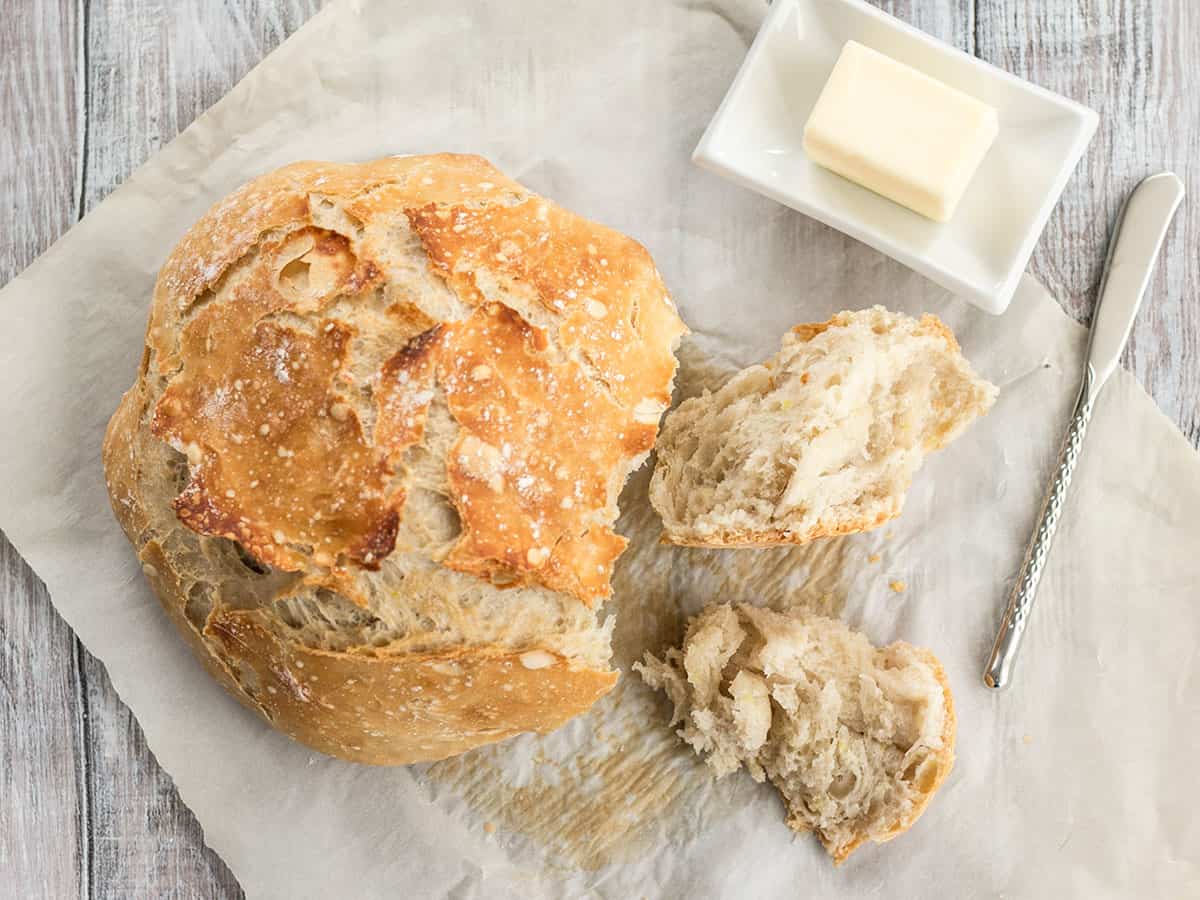
How to Make No-Knead Bread – Step by Step Photos
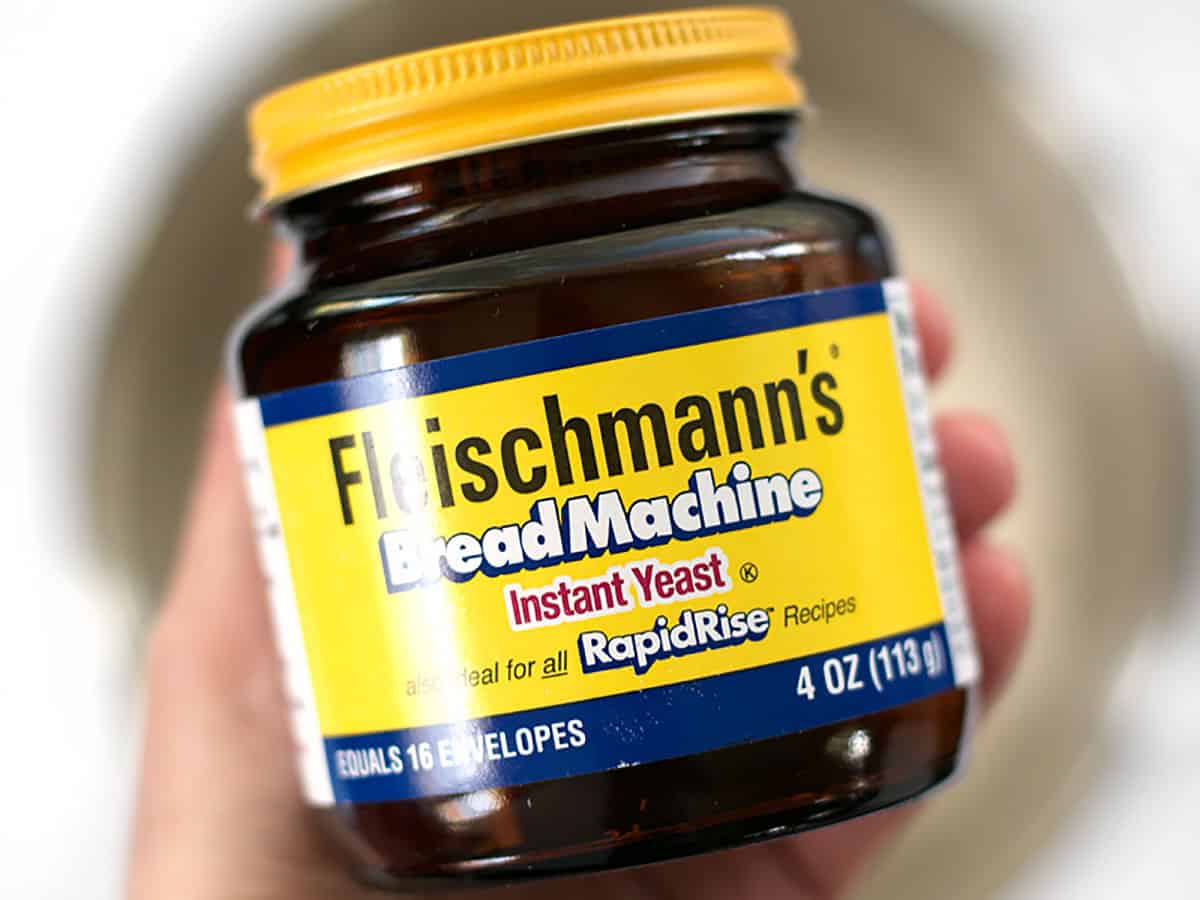
Before you begin, make sure you have “instant yeast” or “bread machine yeast” rather than “active dry”. The reason you need this type of yeast specifically is because it does not need to be kick-started by mixing with warm water first. You can add it to a recipe dry and it will still activate. I buy these little jars, which I keep in my fridge, and they last for-ev-er (especially when you’re only using 1/4 tsp at a time)!
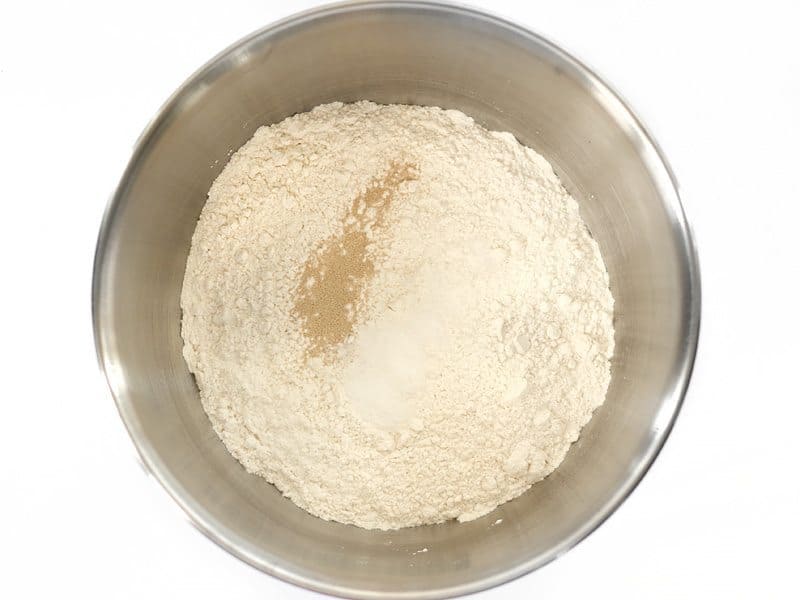
The day before you want to actually bake the bread, combine 3 cups all-purpose flour, 1/4 tsp instant or bread machine yeast, and 1/2 Tbsp salt in a large bowl. Stir them together really well.
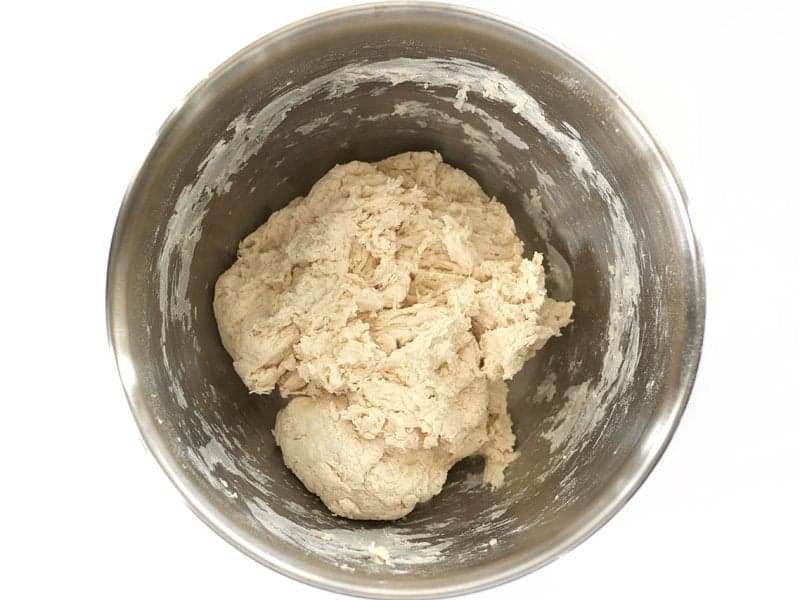
Stir in about 1.5 to 1.75 cups of room temperature water, or just enough to form a shaggy ball of slightly sticky dough, and no dry flour is left on the bottom of the bowl. The total amount of water needed may vary from time to time depending on the ambient humidity and moisture content of the flour, so go on visuals here. Make sure it comes together in one ball and no dry flour is left on the bottom of the bowl. It’s okay for it to be a bit sticky.
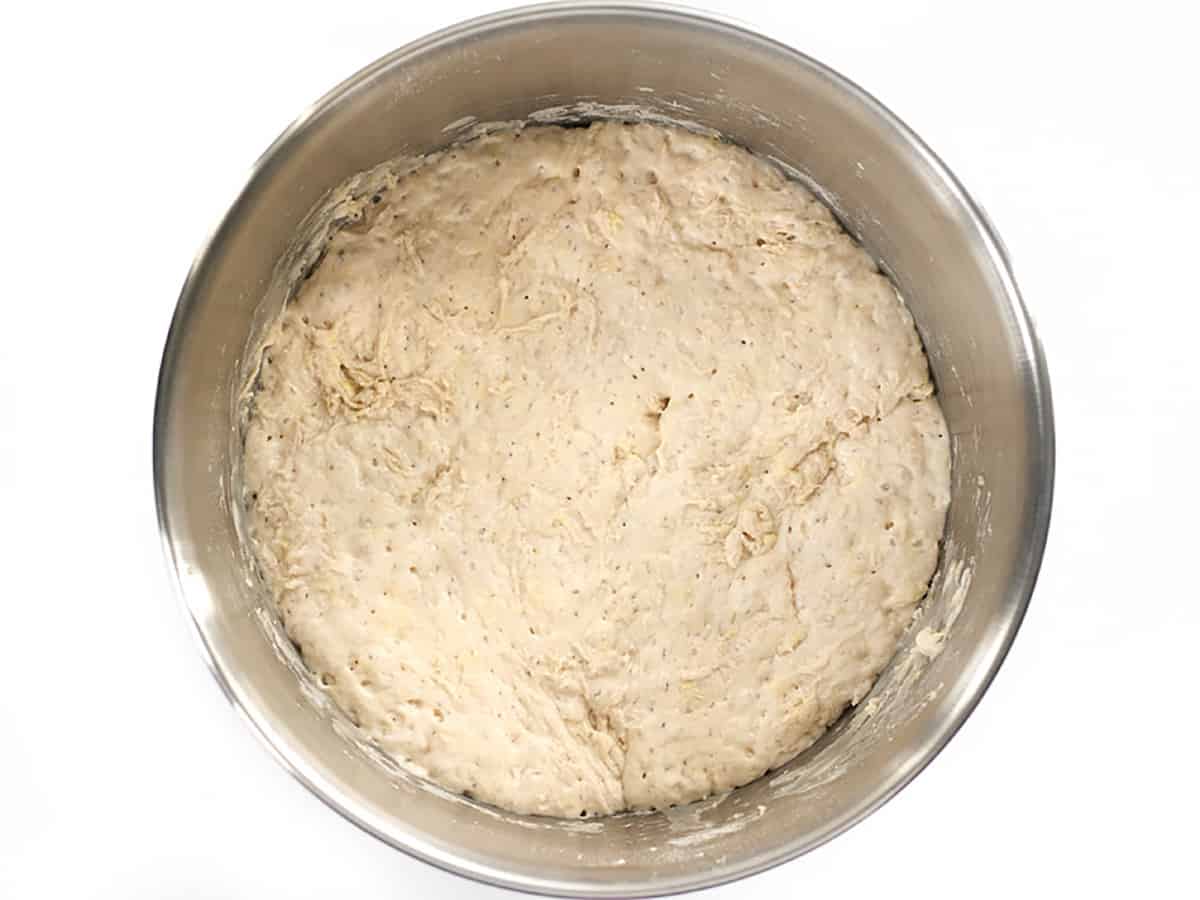
Loosely cover the bowl with plastic and let the dough ferment at room temperature for 12-18 hours. If you need to let it sit longer than that to fit your schedule, just transfer it to the refrigerator. As the dough ferments, it becomes very big, light, fluffy, and bubbly.
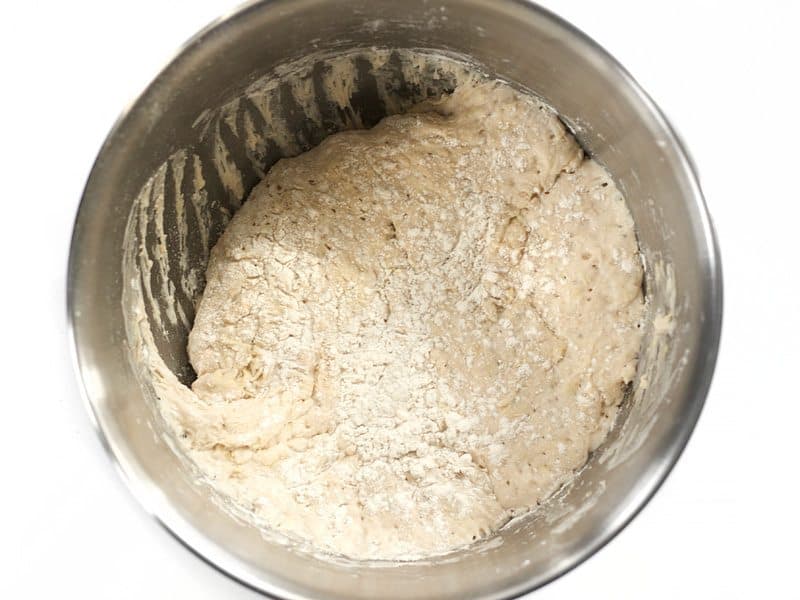
Sprinkle a little flour onto the dough (because it will be sticky) and scrape it out of the bowl. It will begin to deflate as you scrape it out.
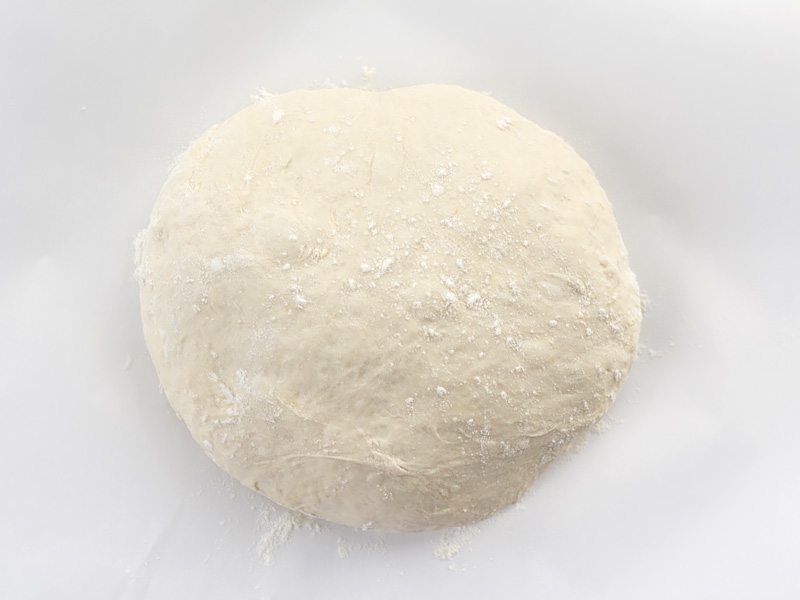
Using floured hands, shape the dough into a ball, then place it on a large piece of parchment. Let the dough rise for 30-60 minutes. The shorter rise time will produce a slightly more dense bread and the longer rise time will have larger bubbles.
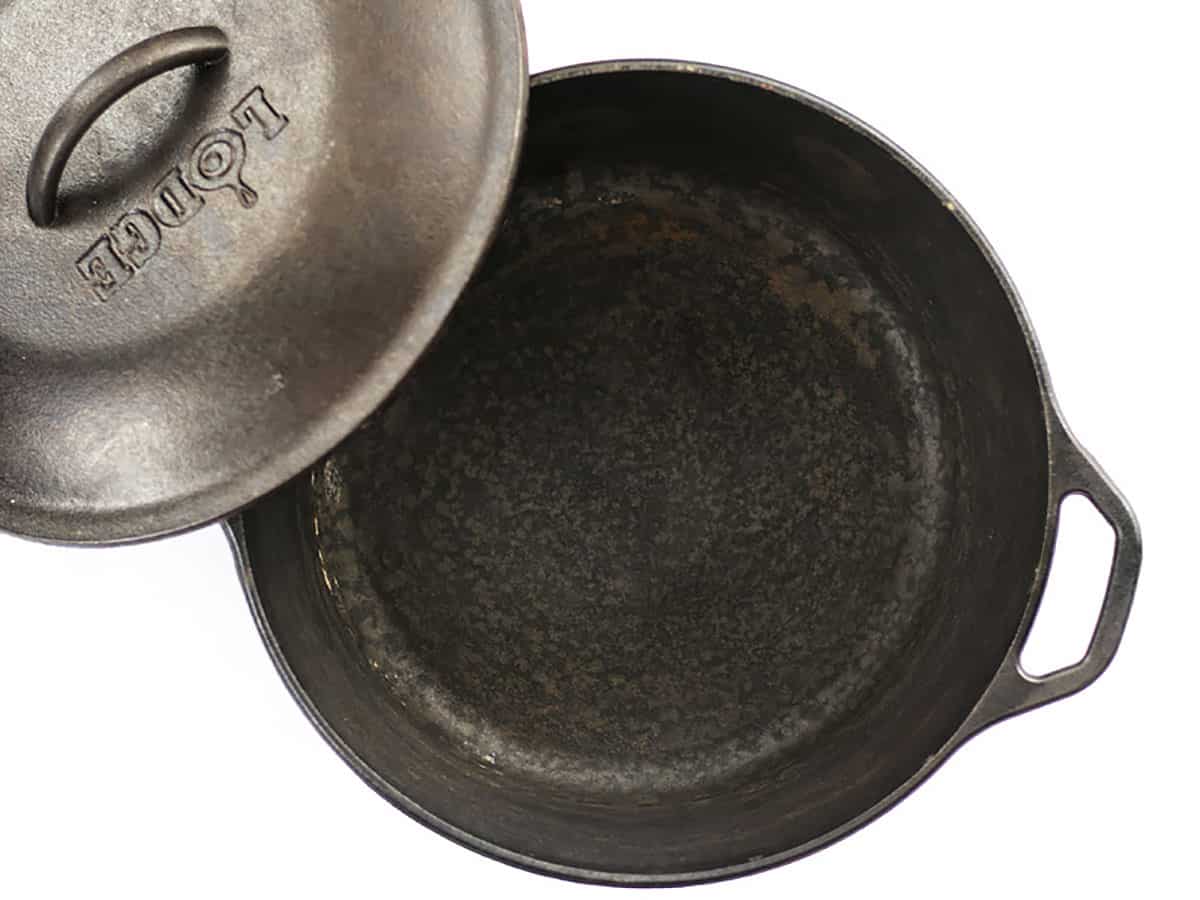
While the dough is rising, begin to preheat the oven and the Dutch oven. Set the oven to 425ºF, or whatever the highest safest temperature is for your brand of parchment (it will usually be listed on the box somewhere). Make sure your Dutch oven is inside the oven as it preheats, and then let it heat for an additional 15 minutes or so once the oven is up to temperature. This makes sure that the Dutch oven is nice and hot.
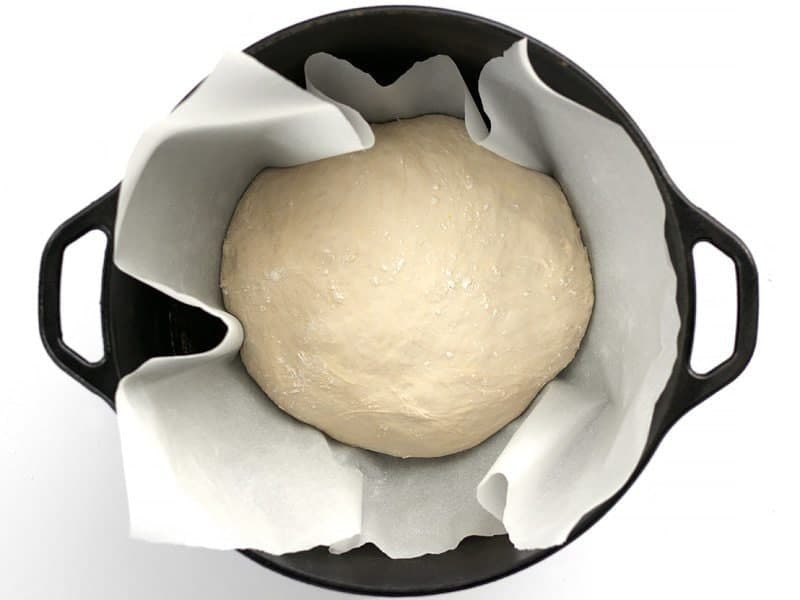
When the dough is risen and the Dutch oven is fully preheated, carefully remove the Dutch oven from the oven (it will be extremely hot!). Lift the risen dough by the parchment and place it inside the Dutch oven, parchment and all. Place the lid on the Dutch oven and return it to the hot oven.
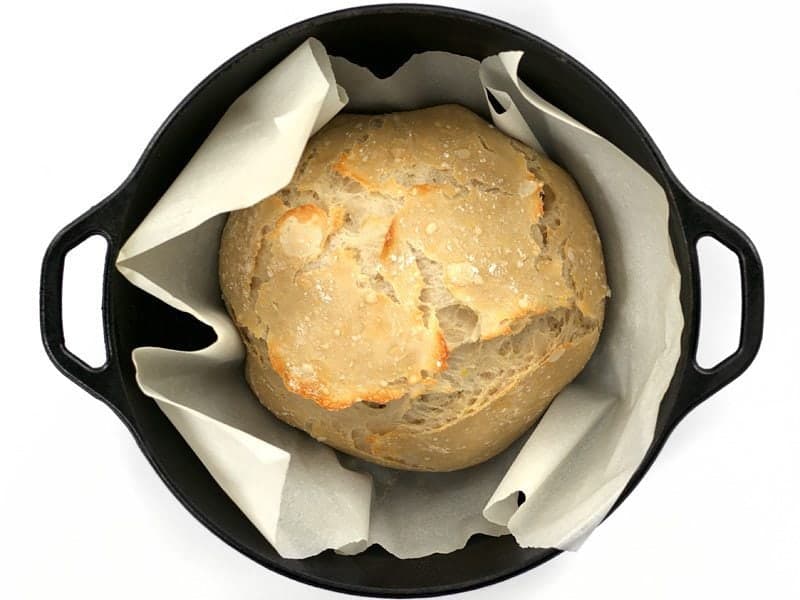
Let it bake for 30 minutes with the lid on the Dutch Oven, then carefully remove the lid…
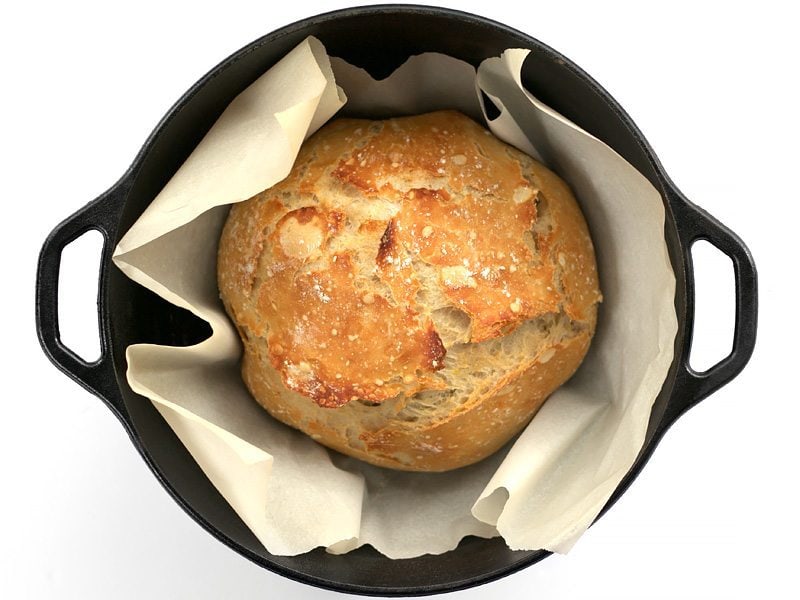
Then bake it for an additional 15 minutes or so WITHOUT the lid to allow the crust to brown.
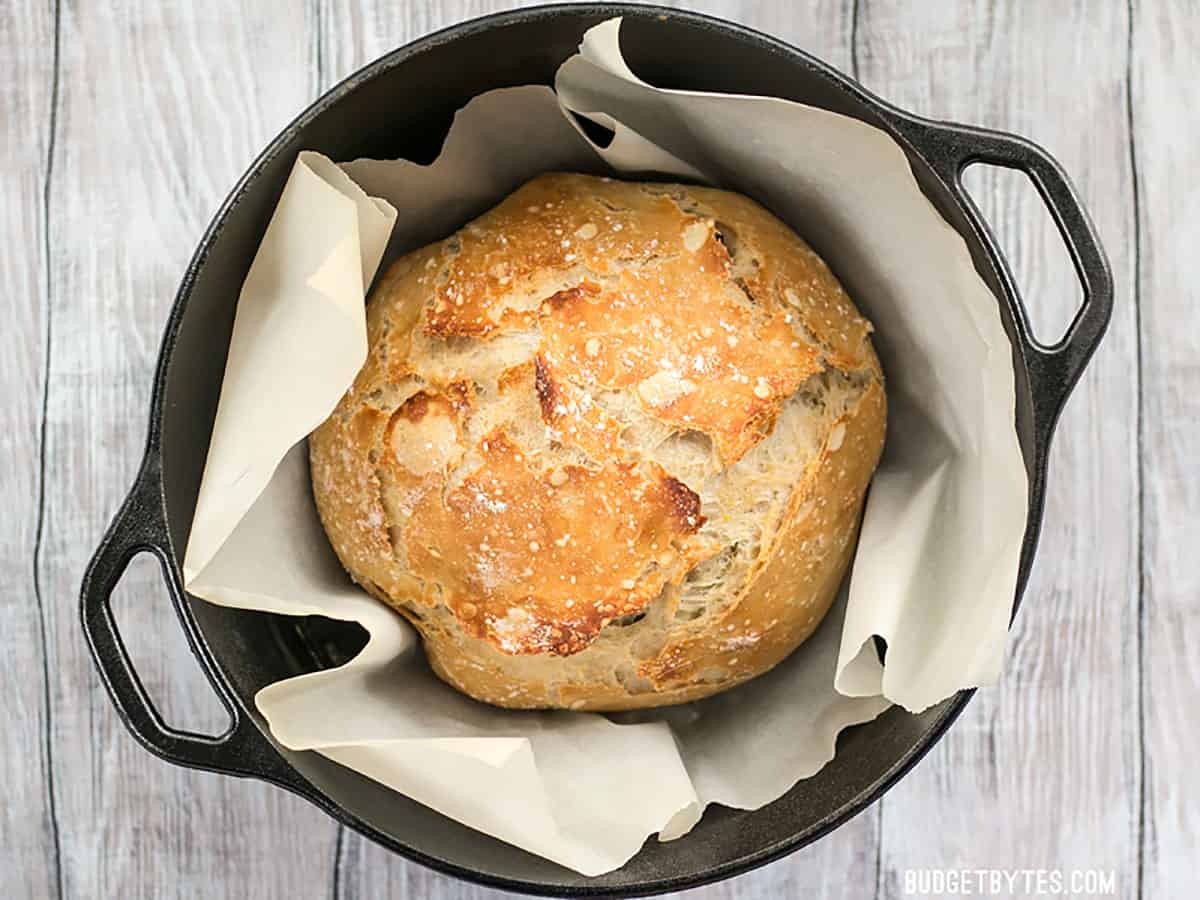
Once the crust achieves a nice deep golden brown color, carefully remove the Dutch Oven from the oven. Lift the no-knead bread out of the Dutch oven by the parchment, and allow it to cool before serving.
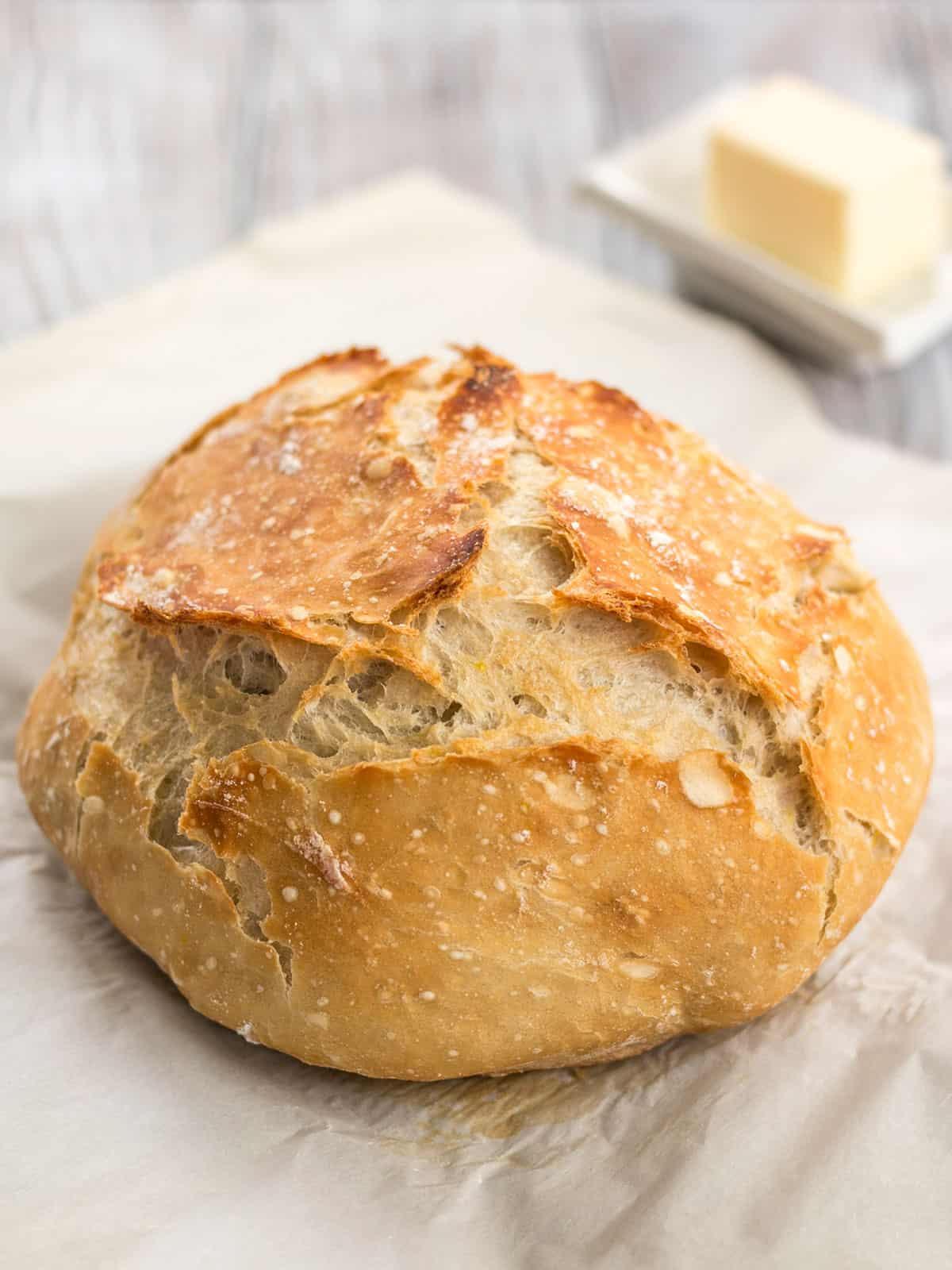
And just be prepared for the BEST bread you’ve ever made yourself. ;) The crust on this no-knead bread is seriously amazing.
No Dutch Oven and Short Fermentation Instructions
So, as I mentioned before, you can still bake this bread without a Dutch oven and with a short, 2-hour fermentation time. Here is a photo of my no-knead bread using just 2 hours of fermentation (plus another 1 hr rise time) and baked on a baking sheet.
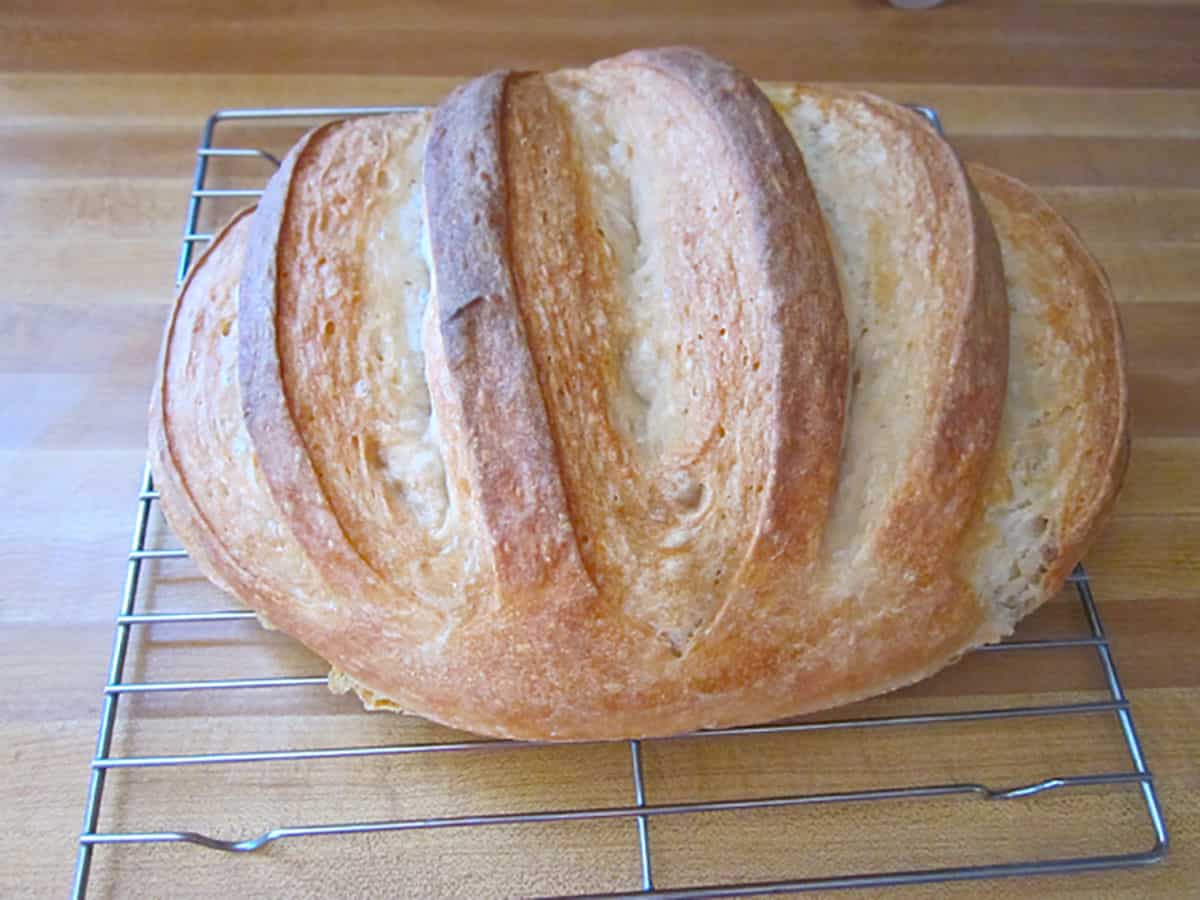
If you only have about 2-3 hours to ferment the dough, you’ll need to increase the amount of yeast used to 2 tsp (instead of 1/4 tsp).
Let the dough ferment in the bowl for 2 hours, then shape it into a loaf, transfer it to a baking sheet covered with parchment (and sprinkled with cornmeal, if desired) and let rise for about another hour. I like to make slits in the top with a sharp knife after the loaf has risen. Be careful though, if the knife is not sharp enough or you use too much downward pressure, it can deflate the dough.
Brush the surface of the dough with water, then bake it in a preheated oven (again, as hot as the parchment will allow, usually around 425ºF) for 30-40 minutes, or until the crust is nicely browned.


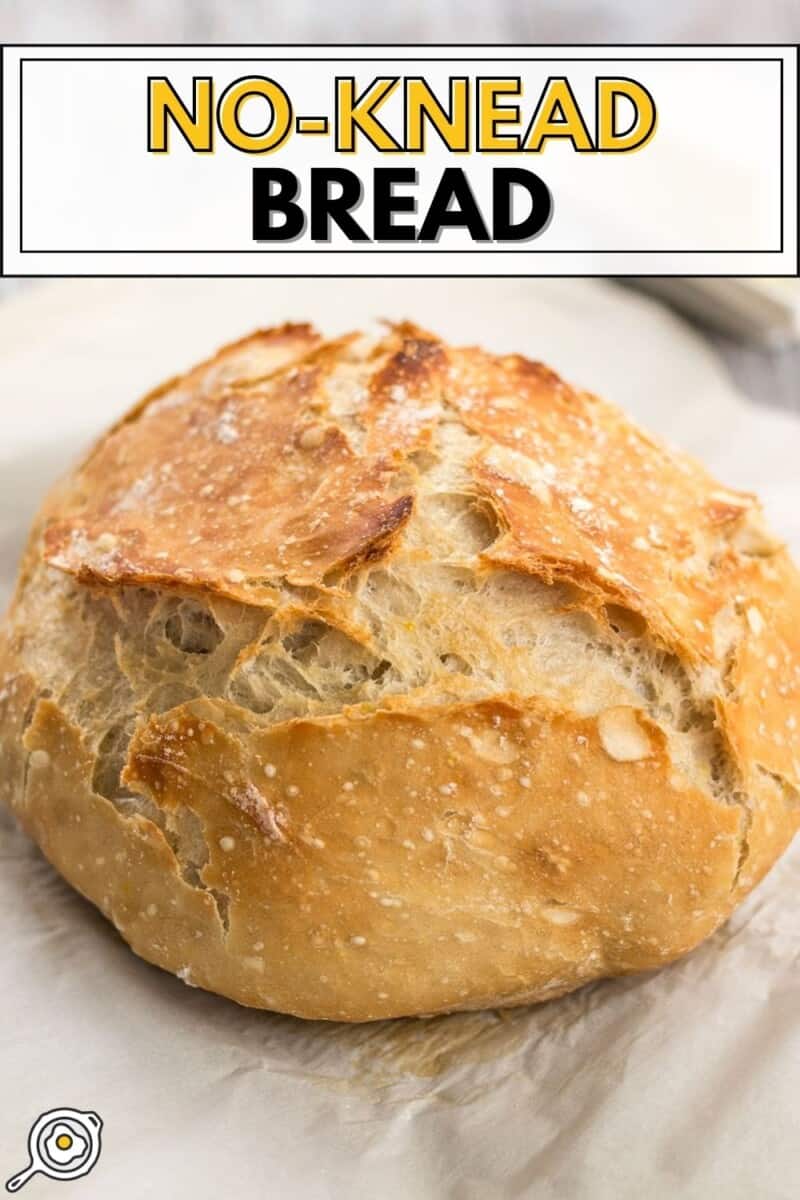
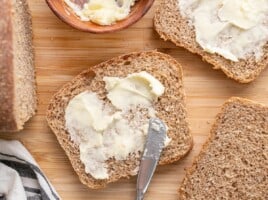
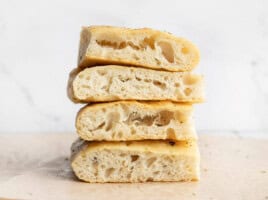
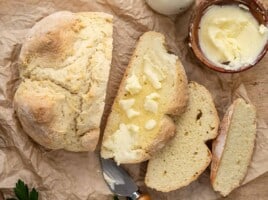
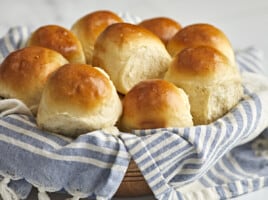
Just a heads up you may want to alter the water needed to “1.25 to 1.75.” I live in a humid area and the first time I made this I made the mistake of just quickly adding an additional half cup of water, assuming that was the least I’d need. It ended up being way too much water, and even with a lot of additional flour and cooking time, the bottom middle of the loaf was slightly damp at the end.
My mistake, as it’s clear in other parts of the recipe that water should be added slowly, but clarity in the ingredient list will help others not do the same thing.
Would this work in a regular bread loaf pan? How about making dinner rolls out of it?
I’ve definitely had good success making rolls with this type of bread (see my Focaccia Rolls), but I haven’t tried a loaf pan. I feel like that might impede the dough’s ability to rise correctly in the oven? Not sure, though.
I have a stainless steel dutch oven (Cuisinart). Would that be OK to use, or would you recommend the baking sheet method instead?
I’d recommend the baking sheet method. You really want the dutch oven to be cast iron or thicker in it’s properties.
Before I got your reply, I decided to try both methods my first time out. The baking sheet method worked great. The stainless steel dutch oven (actually it’s a “saucepot with lid”) seemed to work fine, too, but we haven’t tasted that loaf yet. In both cases, I used 1.5 cups of water, but I think I’ll cut back on it next time, as after the first rising, both loaves were so loose that I couldn’t shape them at all… I just plopped them onto the parchment paper. As a result, the loaves were flatter than I expected. Still, very tasty. I’m looking forward to experimenting some more. Thank you!
I don’t have instant yeast, only regular. How do I adapt this recipe to use that instead?
Can you halve the salt and add a bit of “sour salt” aka Citric acid to make a “mock sourdough”? I know it wouldn’t technically be true sourdough…..which is a problem for me since I always have trouble with making the starter, but this looks like it could be a perfect recipe for the culinaryily challenged such as myself.
Unfortunately I’ve never used a citric acid in bread making, so I’m not sure how that will affect the bread.
I tried this yesterday and it really good! But I suspect my flour to water ratio is off, since the dough was really wet and almost impossible to shape after rising. Awesome that the recipe is forgiving, but could you add in a weight for the flour, so there is no under/over packing during the measurement?
Beth doesn’t use weighted measurements but 1 cup of flour is about 120 grams.
We like a soft crust. If I brush this with olive oil instead of water, do you think it will yield a soft crust? Thank you so much for such an easy recipe. It makes homemade bread seem doable!
My enameled cast iron Dutch oven (Tramontina brand) says it’s only safe to 400 degrees. Would this recipe work at that temperature? Thank you!
Yes you should still be just fine!
Thank you. Dough is rising as we speak and I’ll bake tomorrow morning. Going to sprinkle some “everything” seasoning on top. Should I brush with butter or water first?
Could you make this recipe with whole wheat flour?
I wouldn’t suggest using more than 50% whole wheat flour because at that point it starts to affect the texture and density too much. You may need slightly more water if using some whole wheat flour as well, since whole wheat flour absorbs more than white flour.
How can I make this in a bread machine and with no Dutch oven?
Unfortunately I’ve never used a bread machine, so I can’t give guidance on that.
OMG. This bread is so delicious that I have to be careful not to eat the whole thing all by myself! I don’t have a dutch oven so I followed the “No Dutch Oven and Short Fermentation” instructions. Being a novice bread maker, I was surprised as how easy this bread was to make. Will be making this again.. and again..
Love it Sarah! Great work!
Can I make the no Dutch oven but let Stan a the bread to rise for 16-18 hours?
You could certainly give it a try!
I have active dry yeast. Can I still use that if I let it “wake up” in the water with 1/2 tsp or so of sugar?
I haven’t tried it to know for sure, but it seems like that would work.
I used active dry with the normal instructions and it came out fine. I just let it stand for a little extra (20 hrs instead of 12-18) and full 60 minute on second rise and it came out exactly as you would expect having use instant yeast. The only modification I had was that I used filtered water from the fridge (cold) so I microwaved it for about 35 seconds to get it to room temperature-ish. Wasn’t warm, but may have been a couple of degrees above 70F (‘room’ temp). I’ve made this twice now and it is great. The crust is perfect, the inside is a little ‘sponge’ like, but has good hole formation, and looks exactly as it should. I may try to cut the water by a bit next time too see if a little less moisture will have a drier texture. Still tastes awesome though, and everyone loves it.
Hey Beth! I’ve actually tried a similar variation on this recipe before a few times – but I swear every time I make it, the inside is thick and almost moist and undercooked. I thought that was literally the case the first time so I stated cooking it for longer and longer times, but no matter how long I baked it, it maintained that texture. Then I thought “maybe I’m not letting it cool long enough,” but no – letting it cool until completely cooled didn’t help.
Do you have any advice?
Hmmm, I haven’t ever had that experience, but I’m wondering if maybe it needs to rise longer? Give the center more time to expand? That’s my first guess without being able to watch your process and catch anything that might be happening.
1/2 tbsp salt seems like a bit much – if you are watching your salt intake can you use less salt?
Yes you certainly can.
I’ve made this recipes eaisly 20+ times now. When that happens to me it’s due to the water/flour ratio. Try staying as close to 1.5 cups of water as you can and letting it rise longer for the second time!
I love this bread but am limited to making it by the 12 to 18 hour fermenting time. Would it be okay to mix it the evening before, then after 12 to 18 hours place it in the refrigerator for up to 6 hours and then take it from the bowl to finish the steps? Would it need to get to room temp before removing from the bowl?
Thanks.
Yes, you can absolutely let it do an even slower ferment in the refrigerator. I think you can go ahead and take it out of the bowl while it’s still cold, and then just let it sit and rise a little longer on the parchment. :)
Hi Beth,
I’m excited to try this recipe and others on your blog! My question is – if I don’t have a Dutch oven, do I have to use the short fermentation process? I’d like to try the long fermentation and bake it in my regular oven, but I noticed you only mentioned those processes together. Thanks! :)
Yes, sorry for the confusion! You can do the long fermentation time without the Dutch Oven. The crust and upward expansion aren’t quite as good, but you can definitely do it. :)
Awesome. Thank you! :)